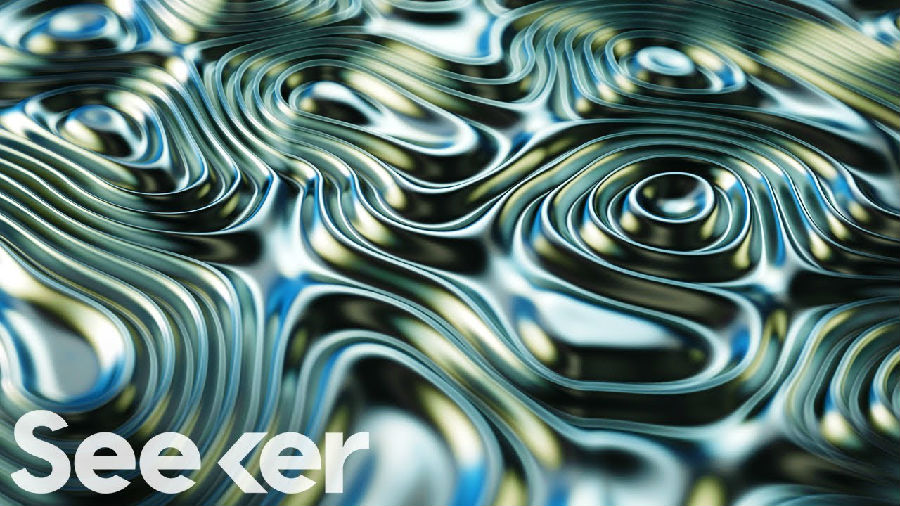Bacteria are everywhere, and they’re incredibly versatile.
细菌无处不在,作用也非常广泛。
They can get us sick, they’re essential good guys in our digestive system...
既可以是病魔,也可以是我们消化系统中必不可少的好东西……
and they can almost defy the laws of physics to create a fluid that basically could power a perpetual motion machine???
甚至还可以超越物理定律,形成一种基本上可以为永动机提供动力的流体???
I didn’t see that coming.
这个倒是超出了我的想象。
Ok, some vocab here.
注意,下面的内容会有一些新词汇噢。
For fluids, friction is expressed as viscosity: the less friction in a fluid, the lower its viscosity.
流体的摩擦用粘度来表示:流体内部摩擦力越小,粘度就越低。
Superfluids are materials that seem to not be bound by the power of friction.
超流体就是几乎不受任何摩擦力约束的物质。
They have ‘frictionless flow’ and therefore zero viscosity,
它们能够“无摩擦流动”,因此粘度为零,
which means they aren’t stopped or slowed down by their own internal motion,
这就意味着它们不会因为自身内部的运动而停止或减速,
and so don’t lose momentum when moving--
所以它们运动的时候就不要失去动量——
give it one first push, and then you’re good. It’ll just keep going.
一开始的时候给它一个推力,你就可以歇着了。因为它会自己运动下去。
For the most part, this property has only been observed in liquid helium when it’s at close to absolute zero,
大多数情况下,这种性质只在接近绝对零度的液氦中才能观察到,
and its behavior is due to some funky quantum stuff.
而液氮之所以产生这种运动也是某种奇怪的量子物质作祟。
But scientists have now observed this phenomenon in water.
但如今,科学家在水里也观察到了这种现象。
I mean can you imagine what could we do with water that moves on its own??
你能想象我们能用自己会动的水做什么吗??
Now, I bet you saw this coming--it’s not just any old water.
现在,我敢打赌你已经预见到了这一点——并不是随便什么水都有这种属性。
It’s water filled with E. coli.
有这种属性的是充满了大肠杆菌的水。
If that makes you squirm a little, trust me--I get it.
你要是听到这儿觉得有点儿难受,相信我,我懂你的感受。
Usually when we hear the name of that bacteria, it’s in the context of a nasty outbreak of a disease we’re hoping not to catch,
通常,我们听到这种细菌的名字是在一场我们不希望感染的疾病爆发了的语境下听到的,
but there’s a lot more to this little creature that the bad rap it catches in the press.
但这种小东西还有很多优点才会被媒体大肆宣扬。
See, usually when you add little bits of things to water, pieces of dirt, clumps of sand, other ‘particulate matter’--
通常,我们往水里加东西,比如加泥土,加沙子或者其他的“颗粒物”的时候——
the motion of the water slows down.
水的运动速度都会逐渐减慢。
That’s because the surfaces of the particulate are exerting extra friction on each other and on the water,
这是因为各个微粒的表面会给彼此以及周围的水增加额外的摩擦力,
giving the fluid a higher viscosity,
继而增加水的粘度,
meaning it takes more energy to keep the whole thing swirling around.
这就意味着需要更多的能量才能让整个东西旋转起来。
You’d think that adding organisms would do the same, but that’s where you’d be wrong, my friend.
你可能会觉得往水里加生物体也会产生同样的效果,但你就错了,我的兄dei。
Bacteria are full of surprises, and not always bad ones.
细菌总是会给我们带来意外,但意外并不见得就都是坏事。
If you put E. coli in water, they swim.
如果我们把大肠杆菌放在水中,它们就会游动起来。
They all swim in their own directions with no real organized movement, they don’t usually have their act together.
它们会按照自己的方向游动,并不会出现有组织的运动现象,因为它们通常不会一起行动。
But if there are enough of them, the ripples caused by each of their little bodies’ movement starts affecting the other bacteria’s directions.
但是如果你加入的大肠杆菌足够多,每一个小身体在运动时产生的水波就会开始影响其他大肠杆菌的运动方向。
Their motion starts to be more collective,
他们的运动就会开始变得更一致,
and when around 10-20% of your water is filled with bacteria,
当大肠杆菌占到了水的容积的10-20%的时候,
they start to form tiny swirling currents.
水里产生微小的涡流。
But at this point their direction and movement are still pretty random, they don’t radically change the behavior of the water.
但这个时候它们的方向和运动仍然是随机的,它们也不会从根本上改变水的行为。
But then when you add a force--say, you put some of this bacteria-filled water between two microscope slides--the motion gets organized.
但是当你给液体施加一个外力——比方说,你取适量的这种液体放在两个显微镜载玻片之间——水的运动就会变得有条理起来。
The shearing force of the glass slide makes all the bacteria align their collective movement in a particular direction
玻璃载玻片的剪切力会使所有的细菌沿着在一个特定的方向运动
because they have these irregularly shaped, oblong bodies.
因为它们的身体形状不规则,呈长方形。
This pushes on the water in a way that makes that water exhibit superfluid properties. Zero viscosity.
这就会给水施加一种作用力,使得水呈现出超流体性质。也就是零粘度的性质。

Those little guys could just keep rollin’ and rollin’ and no one can stop them!
那些小家伙就可以一直游啊游,而且谁也阻止不了他们!
(ok Maren tone it down, no one can know you want bacteria to take over the world)
(好了,莫伦,小声点,千万别让人知道你想让细菌统治这个世界)
The experts are still a little unclear on the nitty-gritty physics specifics of exactly how the bacteria’s motion does this.
目前,专家们还不太清楚这背后的物理学细节原理。
But the effect is real.
但这种效果是真实存在的。
The recently published experimental data is supported by previous theoretical work, and has some crazy real-life implications.
最近发表的实验数据不仅有先前的理论工作的佐证,还有着十分不可思议的现实意义。
Because the motion of a superfluid is frictionless and therefore only needs to be set into motion once,
由于超流体的运动是无摩擦的,所以自始至终你只需要给它一个动力,
there is a potential for it to be used as a ‘fuel’.
这就让它有了充当“燃料”的潜能。
You could set your super-water in motion--which would take some initial energy investment--
我们可以启动超流体让它流动起来——这方面需要一些初始的能源投资——
and then you watch its motion power a motor or a turbine...essentially forever.
然后你就可以看着它在运动的时候给马达或涡轮机提供动力了,而且可以说是提供永恒不断的动力。
(I say essentially because the solid moving parts of the motor itself would probably be slowed down by friction,
(我之所以说“可以说是”,主要是因为马达的固体运动部件本身可能还是会因为摩擦力而减速,
so you’d need to give it a nudge every now and then.)
所以你还是需要时不时地推它一下。)
Plus, when we’re talking about a hypothetical motor,
另外,讨论一个假设的马达时,
at this point we’re talking pretty small and not necessarily that fast.
在这里,我们谈论的是非常小,速度也不需要特别快的那种。
Scaling this operation up in any way is going to require a lot more work.
扩大实验的规模,无论是从哪方面扩大,都需要更大的投入。
And then there’s the whole problem of the fact that the bacteria are living organisms,
还有一个问题就是细菌是活的有机体,
so you have to feed them. You gotta fuel the fuel, so to speak.
所以你得喂它们。光让驴拉磨,不让驴吃草,那哪儿行啊。
And they’re kinda picky--you really have to get their care and feeding right for them to work properly,
而且,它们还很挑——要让它们好好工作,你得好吃好喝得把它们伺候着,
so that’s an issue that needs to be reckoned with.
所以,这也是一个需要考虑的问题。
There’s lots more work to be done in uncovering the details of just how this does what it does,
要真正揭示这背后的细节原理还有很多工作要做,
but superfluids powered by bacteria are exciting.
但是,细菌驱动超流体这个概念就很令人神往啊。
And not just for their potential as a ‘fuel’,
不仅仅是因为它们有充当“燃料”的潜力,
but also because their superfluid characteristics could allow them to move into spaces on their own without having to be forced or injected,
也因为它们的超流体特性可以让它们自己主动进入你预设的空间而不需要强迫或注射,
meaning they could help do things like clear up spilled pollutants.
这就意味着它们可以帮助我们清理溢出的污染物。
But for now, we’re just inching toward that future.
但就目前而言,我们朝着这个未来前进的步伐还很缓慢。
For more on the surprising ways E. coli can generate energy for humans,
了解更多关于大肠杆菌为人类提供能量的神奇方式,
check out my other video here on bacteria-powered solar cells,
大家可以看看我这个关于细菌太阳能电池的视频,
and make sure you subscribe for all things microbes.
记得订阅栏目了解各种关于微生物的视频鸭。
Thanks for watching.
感谢大家的收看。











